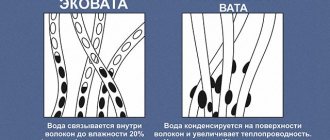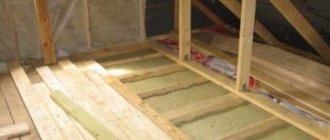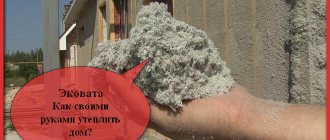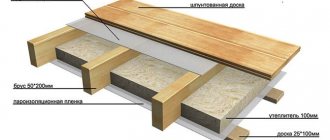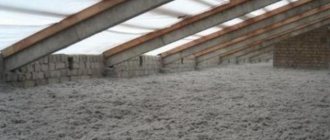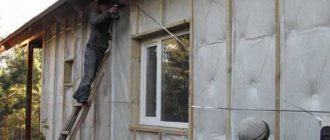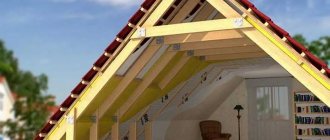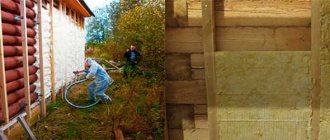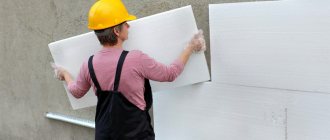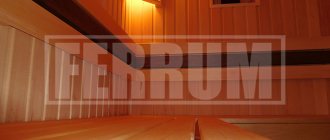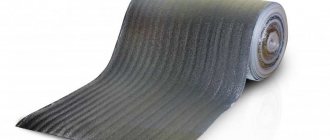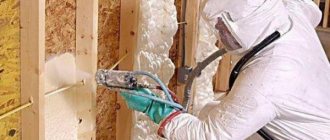No house today is built without thermal insulation. The choice of modern materials allows you to select insulation according to any parameters. When the main criterion is the price of the issue, the range of searches is limited. Among insulation materials typical for the Russian climate, ecowool is gaining particular popularity. The first installations for its production appeared here in 1993, although in Europe this material has been used for thermal insulation of residential and industrial premises since the 30s of the last century.
The construction of Scandinavian frame houses cannot be done without this practical material, and it is no coincidence: insulating residential buildings and industrial buildings with ecowool has its advantages. First of all, it is versatility. Insulation is used in partitions, walls, ceilings, roofing and enclosing structures both in private construction and on an industrial scale. The lightweight material does not weigh down the structure and is durable in use ( up to 70 years ). Several options for ecowool insulation technologies have been developed, differing in the method of its application.
Ecowool after loosening
Table of contents
What are we comparing?
Designed to keep you warm. Seamless installation. Not like fish in water Density and weight Does not burn or does not support combustion? Do you need a vapor barrier? Silence in the home Conclusion Ecowool is a modern thermal insulation material with a low shrinkage rate, good resistance to water, and has high sound insulation properties. A similar characteristic can be found about almost any thermal insulation product, but it is only possible to evaluate how effective the material really is by comparison. In this article we will try to compare ecowool with the most common insulation materials.
Ecowool
Same composition in all countries
I would like to especially draw your attention to the fact that despite the wide geography of application of this insulation, in almost all countries, including Russia, the manufacturing technology of this material, its composition, are almost the same - it includes three components: this is cellulose - newspaper waste paper, this is borax and boric acid .
If everything about waste paper is very clear, then about borax and boric acid, not so much. Let's look at them in more detail:
What are we comparing?
For comparison, let's take insulation materials that are often used to insulate a house: basalt wool and fiberglass-based mineral wool. The choice fell on these materials, since their scope of application is quite wide. They are suitable for insulating walls, floors, roofs, soundproofing partitions, etc.
- Ecowool - 80% consists of cellulose fibers, the raw material for which is recycled paper. The remaining 20% is boric acid and borax. The latter is a fire retardant, which increases the fire resistance of the material. The insulation is made in the form of a loose mixture.
Insulation of the facade using ecowool
- Basalt mineral wool is made from straightened rocks with the addition of phenolic resins; the material is produced in the form of slabs.
Basalt mineral wool has a characteristic brown tint
- Fiberglass mineral wool is made from molten glass or sand. It has a fibrous structure. Often produced in roll form.
Personal protective equipment is required when working with fiberglass
Rules for applying ecowool
If installation is carried out independently, it will be useful to remember a few simple rules:
- An online calculator, which can be found on any construction site, will help you correctly calculate the required number of 15-kilogram packages.
- When applying the material, the following should be taken into account: the optimal insulation thickness for the floor is 15-20 cm, for a sloping roof - 15-20 cm, for floors between floors - 10-15 cm, for attic insulation - 20-30 cm.
- You should purchase material with a reserve of 10-15% for unforeseen circumstances.
- The performance properties of ecowool are designed for insulation of wooden structures. In this case, the material can be applied to the surface without any insulation. If a metal, concrete or brick surface is insulated, insulation is required. Otherwise, condensation may accumulate in the room.
- When insulating high vertical planes, in order to avoid shrinkage of the material under its own weight, transverse dividing partitions should be provided in the frame.
- When thermally insulating the roof, it is necessary to completely eliminate the possibility of condensation forming on the inside of the roof deck.
Compliance with these simple rules will ensure coziness and a comfortable microclimate in your home.
Seamless installation.
Ecowool differs from “traditional” heat-insulating materials in the installation method. Basalt mineral wool and fiberglass are produced in rolls or slabs. They are cut into rectangular pieces and laid between joists, sheathing or rafters, depending on the place where the insulation is installed. Installation of ecowool is carried out using the “dry” or “wet” application method. Thanks to this, a continuous insulating layer is obtained without seams or joints. When laying mineral wool and other slab materials, the seams remain “cold bridges”.
The use of specialized equipment allows you to lay ecowool in hard-to-reach places
Ecowool is laid manually or automatically. Manual is more labor-intensive and does not always allow achieving the same insulation density in all areas. Automated installation is carried out through a blowing machine with a corrugated hose. “Wet” or “dry” application method is selected depending on the surface.
When it comes to installation, it is difficult to choose an undisputed leader. On the one hand, the seamless application method allows you to get rid of “cold bridges”; on the other hand, the installation process itself becomes more complicated. In addition, “wet” styling will require drying time (2-3 days).
Manual styling
This material can be used for insulation in various ways. One of them, industrial, consists of spraying pre-moistened ecowool onto the surface requiring treatment using specialized equipment, as well as pumping dry material into the insulated frame with a powerful compressor.
In addition, you can install the material manually, but this will increase its consumption. This process will take an order of magnitude longer.
The manual method of installing the material is labor-intensive, increased time costs, and the impossibility of completely filling all existing cavities, voids and cracks. But many people prefer this option, since it turns out to be much cheaper.
If you intend to insulate a shed, outbuilding or garage, follow the given procedure:
- Since the material is in a compressed state, it is necessary to fluff it well. You can do this using a drill and a paint attachment. The fluffed material can begin to be used.
- The briquette with insulation is opened, the mass is poured into any suitable container.
- This method of using the material can only be used for filling it into floors (when laying it from above), or for dry laying it into a wall space.
- When filling into floors, the mass should be evenly distributed between the joists and rafters. It is used to fill all the required places until a surface with a slide is formed. When the floorboard is subsequently used, the material will be compacted to the required volume.
- When dry filling the mass into vertically located structures, it should be carefully compacted: the density of the material should become only two times less than the original one inherent in the factory briquette.
Not like fish in water
The relationship between moisture and insulating materials can be described as complex. Here we need to return to thermal conductivity again. Under normal conditions, as we have seen, this figure is approximately the same for different thermal insulators, but everything changes when moisture gets on the insulation. All materials behave differently. The most moisture-sensitive material is basalt mineral wool; when moistened by 1%, its thermal conductivity increases by 9–8%. Fiberglass also does not tolerate water well, but recently products with enhanced moisture resistance have begun to appear.
Moisture distribution inside ecowool and mineral wool fibers
What's going on with ecowool? It absorbs water, but thanks to the fibrous structure, all the moisture gets into the fibers, and the empty space with air (which is the main heat insulator) remains free, as a result, when humidified to 20%, the thermal conductivity remains unchanged.
Ultimately, the water resistance parameter is relevant only in the event of force majeure (roof leakage, waterproofing breakthrough, etc.). Subject to compliance with building codes and regulations, water should not get on the insulation, so this indicator should not become decisive when choosing a particular insulation material.
Self-production of cellulose boards
Is it possible to make more convenient paper insulation with your own hands?
Yes, you can make some kind of thin and dense insulation from waste paper. Whether the result is worth your time is debatable; however it is possible.
Here is a description of the production process.
- The paper is shredded and poured into a barrel. The smaller the fragments, the better the result. Then it is soaked for a day or two. Water should completely fill the paper.
- After this time, water is added to the barrel at the rate of 20 liters per kilogram of waste paper.
- An oil emulsion is made in a separate container: 100 grams of machine oil and water are taken per 200-liter barrel. The mixture is whipped with a mixer and added to the barrel: it will make the material hydrophobic.
- Add 100 grams of soda ash to the barrel (it will reduce the ability of the insulation to ignite) and 20 grams of boric acid (an antiseptic).
- Beat the mixture thoroughly. This can be done with an improvised mixer: three pieces of 4 mm wire are clamped into the drill chuck; then the last 15 centimeters of each segment are bent radially.
- After 5-7 days of settling, the mixture is whipped again. It should become as homogeneous as possible: in this case, the density of the insulation will be minimal, and the yield of useful volume will be maximum.
- We are constructing a mold for the future insulation board. Overall dimensions are arbitrary (you can focus on 50x100 centimeters). The bottom is a mesh on a solid base that allows water to pass through, or simply polyethylene pierced in several places with an awl and laid out on flat sand.
Density and weight
The higher the density of the insulating material, the greater its weight per unit area. With greater weight, the requirements for supporting structures increase. This is especially true when installing a roof. Also, in the case of ecowool, the density is affected by the uniformity of application.
Read about the features of choosing insulation for a roof in the article: “How to insulate a pitched roof.”
- Basalt mineral wool – 25 – 50 kg/m3 depending on the brand
- Fiberglass – 15 – 20 kg/m3
- Ecowool - 35 kg/m3 for horizontal structures and 65 kg/m3 for horizontal ones.
Thus, from the point of view of numbers, the materials do not differ much, but at the same time, applying ecowool to vertical surfaces with insufficient density can lead to subsequent shrinkage. Due to the specifics of application, the density in different areas is not the same.
How much wool is needed to insulate a house?
How much ecowool does it take to insulate a house?
For example, let's take a one-story house with an area of 100 square meters. m. (dimensions of the building – 9x11 m. ). We start calculating ecowool by determining the surface area that needs to be insulated.
- External walls: (9+11)*2 = 40 m – this is the perimeter, multiply it by the height of the room (3 m) and get 120 sq. m of wall area. Insulation layer – 200 mm (150 + 50 cross). We convert everything into meters and multiply by the thickness of the layer: 120 * 0.2 - 24 cubic meters. m. We will blow cotton wool into the walls with an approximate density of 65 kg/cub.m. As a result, we get 24*65 = 1560 kg of material using the wet method.
- Internal walls: let's say the interior is 100 square meters. m of side surface. With a thickness of the insulating layer of 100 mm, 100 * 0.1 * 65 - 650 kg of material will be required. In total, double insulation requires 1560 + 650 = 2210 kg.
- Floor. We determine the floor area: 9*11 = 99 sq.m. With an insulation thickness of 200 mm, you will need 99 * 0.2 = 20 cubic meters. m (approximately). To cover the attic, you need to increase the layer to 300 mm. Total: 99*0.3 = 30 cubic meters. For 2 floors – 50 cubic meters. With horizontal dry blowing, the density is 35 kg/cub.m. total – 30*35 = 1050 kg.
So, for a one-story building with a layer of 200 mm. for the floor, 200 ml. for walls and 300 ml. for the attic you need 3260 kg. insulation. In a standard bag - 15 kg , it turns out 218 bags (approximately, but it’s always worth taking with a reserve). The price of a bag of ecowool is about 500 rubles. The cost of this quantity is approximately 115,000 rubles. Calculations are approximate; you can reduce the layer in the attic (if there is not enough material).
Ecowool is laid on the prepared base
Calculation of the cost of insulating a house on your own and by installers
For one cubic meter of floor insulation, professionals have to pay 2 thousand rubles . For self-installation, a cubic meter will cost 1,750 rubles. at a density of 50 kg/cu.m. Professional application using an installation ensures a density of 40 kg/cu. The difference per cubic meter is 250 rubles. If you need to compact 100 sq. m with a layer of 200 mm, yields 20 cubic meters. or 5 thousand rubles difference. If you compare it in time, the compressor will do this work in an hour and a half, and manually this amount of work will take 30 hours. Similar calculations will be made when insulating floors.
The excess is trimmed off - it is suitable for reuse.
Doesn't burn or doesn't support combustion?
Flammability is a parameter that you need to pay close attention to; the overall fire resistance of the entire building depends on it. According to GOST, there are 5 flammability classes: NG (non-flammable), G1 (low-flammable), G2 (moderately flammable), G3 (normally flammable), G4 (highly flammable).
Ecowool does not support combustion, so fire does not spread into the material
- Basalt mineral wool is NG, while slabs containing phenolic binders can emit toxic smoke.
- Fiberglass-based mineral wool is non-flammable, but at temperatures above 500 degrees the material begins to melt, so the flame can spread to other objects.
- Ecowool - G2, upon contact with an open flame, the insulation burns, but does not support combustion (the fire does not spread deep into the material). The advantage is the absence of toxic smoke.
Based on the results of comparing flammability classes, ecowool cannot be called the most fire-resistant material. It should not be used near chimneys, stoves or fireplaces.
The best ecowool manufacturers
Currently, a large number of large and small enterprises are engaged in the production of insulation. Below are the most famous manufacturers.
Isofloc
A German company specializing in the production of universal building materials and various insulation materials, in particular ecowool.
Termex
A Finnish corporation that focuses on the quality and environmental safety of its products. High quality is successfully combined with an affordable price.
Ecovilla
The products of this enterprise have become widespread due to their high quality, affordable price and environmental safety.
Ecowool Extra
A domestic company was one of the first to launch the production of ecowool in Russia. The company's products meet all the requirements of international standards, while the cost of manufactured products is significantly lower than that of foreign analogues.
Greenfiber
An American company that uses the latest technologies, thanks to which the company's products are characterized by high performance characteristics and a long service life.
Equator
A Russian company specializing in the production of a wide range of building materials. The company's products meet all international standards, are of high quality and affordable.
Among domestic manufacturers you can also find Nanovata. These enterprises may well compete with leading Western manufacturers.
Is vapor barrier necessary?
A vapor barrier protects the insulation in a wall or roof from vapors that escape from the house. Warm air, meeting cold air, condenses at the dew point, which usually falls right on the insulation. As we have already figured out, moisture does not have the most favorable effect on thermal insulation material. You can often come across the opinion that when insulating with ecowool, a vapor barrier is not needed. This is not entirely true, because moisture may not damage the insulation itself, but will cause rotting of other structural elements (walls, sheathing, etc.).
- Basalt mineral wool - vapor barrier needed
- Fiberglass-based mineral wool - vapor barrier needed
- Ecowool - it is recommended to use vapor barrier in places with high humidity.
Roof insulation with ecowool
At the preparatory stage, the roof is waterproofed and the load-bearing capacity of the rafter system is checked. If necessary, it is reinforced with wooden beams and metal profile structures. The attic is cleared of debris, and protective screens are installed in places where cables are laid to ensure access to them after laying the wool. Before blowing, you should analyze all the spaces that need to be filled: those formed by the side rafter beams (the thickness of the layer will be identical to the width of the rafters), the upper windproof board, the lower vapor barrier. The insulator exerts a certain pressure on the base, so it is important to check the gap between the vapor-permeable membrane. Lay only high-quality material on the timber and without sagging. The counterbar should create a gap of 45 mm. At the bottom, the material is fixed with a 20-40 mm beam.
Prices for different types of bars
Bar
Layer cake when insulating the attic
Insulating the attic roof requires compliance with the following rules:
- thermal insulation must be protected from excess dampness;
- ventilation in this technology is mandatory;
- The cotton wool is laid in a uniform monolithic layer.
The roof pie consists of a roofing covering, frame, waterproofing layer, ecowool, vapor barrier and finishing material from the inside. The geometry of the roof is quite complex, so wet technology is recommended. Insulation instructions:
- Cover the roof frame with film. At the joints, the sheets are connected with construction tape.
- Spray a layer of ecowool on the surface. It is applied from bottom to top to prevent the top layers from slipping.
- After the insulation has completely dried (up to 2 days), it is covered with a vapor barrier film. The canvases are secured with a stapler.
- The roof is sheathed along the sheathing with plasterboard, siding, and wood.
Features of attic insulation
Video - How to insulate a roof with ecowool
Conclusion
Based on the results of comparison with other thermal insulation materials, we can highlight the positive and negative aspects of ecowool.
Advantages:
— Seamless application does not form cold bridges.
— Adhesion to the frame provides increased heat and sound insulation.
— Thermal conductivity does not increase when wet
— Good vapor permeability (0.35 mg/(m h Pa)
— Filling hard-to-reach places by blowing cotton wool
— Environmentally friendly - does not contain formaldehyde resins, consists of 80% cellulose
Dry method
The dry method is also applicable for insulating ecowool walls on the indoor and outdoor sides. As a rule, it is used when necessary to fill the voids in the walls of frame houses. Insulating the roof with ecowool using a dry method is also possible, but only if there is a frame to fill it with heat-insulating material. Ecowool consumption with this method is 10-15% more economical than when applying insulation using the wet method.
Before you start applying insulation, you need to prepare it. The raw materials arrive in pressed form, so it will be impossible to apply ecowool in a commercial form. Modern equipment has the function of fluffing raw materials with a built-in mixer, but if this is not available, then the composition will need to be fluffed manually. Subsequently, under the influence of high air pressure in the hose, the composition will reach the required state. The degree of “fluffiness” of the raw material affects the penetration of insulation into all corners of the cavity, providing maximum coverage.
Boric acid
Boric acid (orthoboric acid or lat. acidum Boricum) is a weak, monobasic Lewis acid, often used as an insecticide, antiseptic, and fire retardant.
In the photo "Boric acid"
Application
- Boron fertilizer
- Used in laboratories to prepare buffer solutions
- In medicine - as an independent disinfectant for adults, and also in the form of a 2% solution - for washing the skin after contact with alkalis
- Also, various combination preparations are produced based on boric acid (ATX group D08AD), for example Teymurov’s paste
- Registered in the food industry as food additive E284
- In jewelry - as the basis of fluxes for soldering gold-containing alloys
- In everyday life - extermination of cockroaches, ants, bedbugs
- In the production of ceramics, fiber optics, fiberglass, glass
- As a fire retardant to protect wood
- As part of electrolytes for copper and nickel plating
General principles of thermal insulation
The correct technology for thermal insulation of floors consists of five main stages:
- dismantling old floors;
- installation of rough (technical) floor;
- laying insulation and securing it;
- laying a hydro-vapor barrier over the insulation;
- installation and securing of the finished floor.
Each specified stage must be carried out with the utmost care. If errors are made during the installation process, correcting them may require large amounts of time and money. Therefore, it is not recommended to carry out work without prior preparation, in a hurry and without due care.
Pros of high capillary activity
- When moistened, the insulating properties of the insulation are preserved.
- Due to the redistribution of moisture through the capillaries, there are no zones of local waterlogging.
This is important when there is some kind of defect in the vapor barrier.
3. Condensation does not form in Ecowool.
4. Ecowool, due to the capillary mechanism, can affect the humidity of the room air. It absorbs excess moisture and releases it when the room becomes dry, that is, like wood fiber, it is a passive regulator of air humidity in the room.
If you do not plan to install supply and exhaust ventilation, then this property will significantly add comfort to your home.
